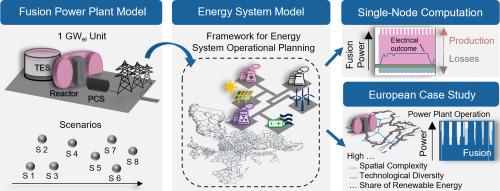基于MIP机组承诺模型的磁约束核聚变电厂运行规划
IF 2
3区 工程技术
Q1 NUCLEAR SCIENCE & TECHNOLOGY
引用次数: 0
摘要
一旦磁约束聚变发电厂商业化,它们必须与其他能源供应技术竞争。能源系统规划模型可以深入了解这些供应技术的运作和相互作用。由于其特殊的运行行为和功率要求,在能源系统建模中需要专门考虑核聚变电厂。本文提出了一种基于多状态技术经济模型的核聚变电厂最优调度估计方法。在混合整数规划框架下,建立了托卡马克和仿星器型电厂的模型,通过最小化电厂的可变成本来优化电厂的运行。多种反应堆状态——热、停、生产启动和生产——及其相应的损失被定义。首先在简化的单节点模型中验证该操作。接下来,将结论转移到2050年空间和结构复杂性更高的欧洲电力系统模型中。研究了各种设计途径对运营策略的影响。结果表明,两种类型的反应堆都将在负荷跟随模式下运行。与没有核聚变的情况相比,假设使用20吉瓦的核聚变发电,欧洲电力市场上的二氧化碳排放量可以减少20%。观察到核聚变电厂运行的显著季节性差异。托卡马克反应堆平均每年运行4043个周期(2小时脉冲长度),而仿星器反应堆平均每年运行474个周期。本文章由计算机程序翻译,如有差异,请以英文原文为准。

Operational planning of magnetic confinement fusion power plants using a MIP unit-commitment model
Once magnetic confinement fusion power plants are commercialized, they have to compete with other energy supply technologies. Energy system planning models can give insights into the operation and interaction of such supply technologies. Due to their specific operational behavior and power requirements, fusion power plants need dedicated consideration in energy system modeling. In this work, we present an approach for multi-state techno-economic modeling of fusion power plants to enable the estimation of their optimal dispatch. Models of tokamak and stellarator type plants have been developed in a mixed-integer programming framework for unit commitment, which optimizes the operation of a complex of power plants by minimizing their variable costs. Multiple reactor states - hot, dwell, production-start and production - and their corresponding losses are defined. The operation is first validated in a simplified single-node model. Next, the conclusions are transferred to a European power system model for the year 2050 of much higher spatial and structural complexity. The impact of various design pathways on operational strategy is examined. The results show that both reactor types would operate in a load-following mode. By using assumed 20 GWel of installed fusion power, 20 % of CO2 emissions can be saved in the European electricity market compared to a scenario without fusion. Significant seasonal differences in the fusion power plant operation are observed. The tokamak reactor operates on average 4,043 cycles per year (2 h pulse length), while the stellarator reactor operates on average 474 cycles per year.
求助全文
通过发布文献求助,成功后即可免费获取论文全文。
去求助
来源期刊

Fusion Engineering and Design
工程技术-核科学技术
CiteScore
3.50
自引率
23.50%
发文量
275
审稿时长
3.8 months
期刊介绍:
The journal accepts papers about experiments (both plasma and technology), theory, models, methods, and designs in areas relating to technology, engineering, and applied science aspects of magnetic and inertial fusion energy. Specific areas of interest include: MFE and IFE design studies for experiments and reactors; fusion nuclear technologies and materials, including blankets and shields; analysis of reactor plasmas; plasma heating, fuelling, and vacuum systems; drivers, targets, and special technologies for IFE, controls and diagnostics; fuel cycle analysis and tritium reprocessing and handling; operations and remote maintenance of reactors; safety, decommissioning, and waste management; economic and environmental analysis of components and systems.
 求助内容:
求助内容: 应助结果提醒方式:
应助结果提醒方式:


